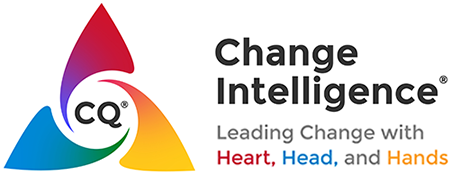Both individuals and teams have a change style and level of change intelligence (CQ), and the same is true of every organization. Some companies thrive on change, responding deftly to new economies, technologies, and customer expectations, while others are slow to adapt, and still others fail to change effectively and thus die.
Unfortunately, most companies fall into the latter two categories. Why do most organizations fail to achieve their lofty transformational goals? Often, it’s because one or more of these is the case:
- Change is not championed by leaders high enough in the organization.
- The new change is led just the same way the last change was (which probably failed or was less than stellar).
- There is no consistent approach to change. At best, there are pockets of “strategic planning” or “change management” methodologies sprinkled throughout the organization—perhaps a project management methodology used in IT, or a change management model touted by human resources—but they are not endorsed or deployed company-wide.
- Leaders are not trained in change leadership. At best, they may have attended a class in change management, but they have had no opportunity to understand or develop their competency as change leaders. When change happens, they’re under fire and have no time for reflection or coaching.
- Leaders lack awareness about what encourages people to embrace change, making it almost impossible to adapt to the needs of various audiences, lessening the probability that those stakeholders will get in action consistent with the change.
- Resistance is ignored or perceived as a force to be overcome. The focus is on doing something to the resisters, not with or for them, even when they can potentially provide valuable perspectives. Resistance continues, expands, and ultimately derails the change process.
Sound familiar? When you look at the last change project you were involved in, can you see one or more of these dynamics at work? In isolation or in combination, they are the death knell for over 70 percent of major change initiatives. When these projects fail, the investment is wasted, employee cynicism grows, and loyalty and trust are eroded.
Just as for individuals and teams, an organization’s CQ can grow over time. Individuals can become more powerful change leaders through diagnosing and developing their own CQ, and teams can become more impactful in leading a change initiative through a CQ-based team-building experience. In the same way, the more CQ is infused into an organization—layered up, down, and across it—the more positive, predictable, and pervasive the company’s results will be.
CQ at the organizational level isn’t an add-on program, another task to complete, or another box to check. Rather, it is a model and mindset that empowers individuals, teams, and organizations to fundamentally alter the way they lead any kind of change initiative. When deployed effectively, the CQ approach becomes “how we do change in this organization,” not just an appendage that’s sometimes used and sometimes isn’t. Companies that use the CQ System in this way find that it becomes a common language and a compass that points the way toward promising new outcomes.
Once members of an organization understand that they need to inspire the Heart, engage the Head, and help the Hands in each and every change initiative, they can employ a variety of other tools to heighten their change intelligence. Are executives committed to sponsoring the change? Perhaps a Leadership Alignment tool can help (to inspire the Heart). Are managers aware of the change and informed sufficiently so they can cascade the message to the troops? Perhaps they can utilize communication-planning methodologies (to engage the Head). Are frontline employees trained to use the new technology? Supervisors can deploy a learning plan (to help the Hands). In this way, CQ enables appropriate integration of methodologies from a variety of disciplines, spanning from change management to project planning and beyond.
Without an understanding of CQ, these types of tools are often deployed slavishly, to every project, whether they are needed or not. Or they are not used at all or not at the right time or in the right ways. Knowledge of CQ alerts leaders to when and how these supplemental approaches may make a positive difference. Furthermore, once a common toolkit of methodologies is installed across the system, everyone—from executives to the front line—will be singing off the same sheet of music, so to speak. No longer will helpful tools be used haphazardly; instead, everyone will be working in clearly understood and consistent ways to make the change come to life.
To paraphrase a TV commercial, CQ doesn’t do change, it helps you do change better. The CQ System helps leaders integrate additional tools at the right time in the right way to ensure that everyone is on the same productive path toward real organizational change.
To put the CQ System to work in your company and enhance its ability to lead change, you need to:
- Start at the top.
- Develop change leaders at all levels. Provide formal training as well as manager and peer coaching.
- Cascade down and move across the organization. Plant many seeds.
- Utilize the CQ methods and tools to develop a consistent language and approach to change.
- Integrate other change methodologies to develop a system-wide change toolkit.
- Avoid labeling initiatives as “programs.” Change is constant and ubiquitous. Treat change like a way of life, which it is.
- Practice courageous conversations. As Ken Blanchard and Spencer Johnson remind us in their book The One Minute Manager, “Feedback is the breakfast of champions.” Get feedback and feedforward (ala Marshall Goldsmith), from above and below.
If you regularly revisit these strategies and apply them in your organization, you’ll soon begin to see the benefits of the CQ System across the company: change happens with less resistance and strife, becomes part of the organization’s essence (rather than evaporating after a short period of time and leaving you short on results), and leads to positive outcomes at every level.
